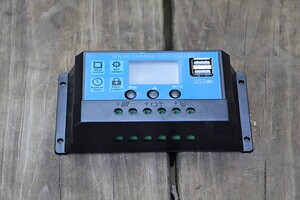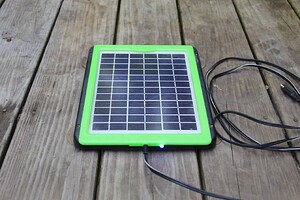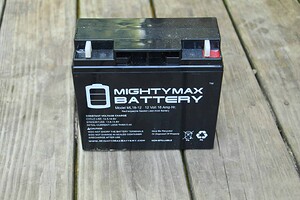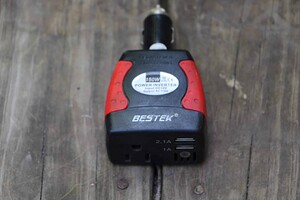You don’t have to go big right away with solar. A small solar backup power system is an excellent way to gain experience with solar or just have some backup power if there is a power outage in your area. Small solar arrays are great for camping, boating, and those that live in RVs part or full time.
My husband and I built a house with a small solar system that powers most of the lighting in our home. We also have 12V outlets we can use when we want. Our plans include switching most of our home over to solar power, including our well pump.
Since we have a small farm, we have several small mobile solar arrays. Currently we have the Jackery 1000 and 500 power center as well as a Goal Zero Yeti 400.
Advantages of Solar Power Stations vs. Gasoline Generators
You can use solar power stations inside.Gasoline generators produce exhaust. You could set it up so that your solar station is entirely inside, with connectors running to panels that are outside.
Solar power is practically silent.
A tiny quiet fan is all you will ever hear. Gasoline generators can be fairly loud and draw attention. During a long emergency, the last thing you want is everyone knowing you have power when they don’t.
Gasoline generators mean you are dependent on gasoline.
The cost and availability of fossil fuels are concerning. Considering that we are in the 4th turning, reducing reliance on fossil fuels is advisable. Just this week, the Colonial Pipeline, the supplier of 45% of the gasoline on the East Coast of the United States, shut down due to a cyber attack. At the time of writing, they are still working on getting this issue resolved. If it is not, then we will see shortages and higher prices within days.
Straight Out of the Box Solutions
Jackery
Jackery is an affordable and lightweight brand that my husband and I have been using for years. During my time writing for Backdoor Survival, I received several different units in exchange for an honest review. I do not take any commission for recommending these units.
Advantages
- Lightweight
- Lithium-Ion Batteries
- Several Sizes to meet your needs and budget
- Rugged
- Great for use on the farm
The smaller centers are great for those that live in apartments, dorms, campers, or that like to get out in the woods but want a little electricity for lighting, music, etc. Any of these units could provide a good backup power source for those that live alone or if you wanted to make sure that elderly relatives have a backup for medical equipment or lighting during power outages.
Large Whole House Back-Up Systems
Goal Zero Yeti 3000x and 6000x
<img class=" src=“https://peakprosperity.com/wp-content/uploads/2021/10/1b7c4c1ad27d3f11a448e883568bd1fd.jpg” width=“384” height=“384” />
If you are interested in a straight out-of-the-box system that can take on the power needs of your entire home, then you should consider the larger Yeti systems. Yes, they are a serious investment at around $3,100-$5,000, but you don’t have to do any major configuring or work. The 6000x will power a standard refrigerator for 110 hours on a single charge. The costs I quoted do not include solar panels. The Yeti can be charged from a 110V plug in at your house in about 12 hours. Solar charging times will vary. This does mean that you can buy your power center and add panels later.
Types of Panels
The cost of solar panels has decreased a lot over the last decade. My husband and I have started to purchase American-made solar panels on eBay for under $1 per watt. Most panels will work with various power centers and systems as long as you have the right connectors or cords. Product manuals often tell you what you need but sometimes you have to do a bit of research yourself or call some manufacturers.Portable panels are nice to have for mobile applications. There are several styles to choose from.
Folding Panels
Smaller folding panels can be attached to a backpack to charge devices as you walk. They have USB ports for charging. Usually, these are standard USB ports, so you should make sure your cables are compatible. These panels can be used with portable power centers as well. They are not always made as durable as you might think. Always follow the guidelines that come with your panel. Leaving them out in bad weather can damage some styles. You can get folding panels in a wide range of sizes. Amazon sells some that are over 300 watts! You can always have multiple folding panels on hand to up your wattage when needed.
Semi-Rigid flat panels
These are very thin panels that weigh 25% as much as a standard panel of comparable wattage. They are great for those that want to mount panels on golf carts, UTVs, or roofs that they do not want to stress too much. You can also store them in an RV and put them out when you park. They are usually a better value than folding panels.Power centers have a max amount of inputs that you can use to charge. This means that more panels do not always mean faster charging.
Building Your System
There are some advantages to building your solar arrays.- Less expensive per watt
- Customized to meet your exact needs
- Usually easy to expand when needs change, or your budget allows
List For Homemade Basic Solar Set Up
Charge ControllerSolar Panel
Battery
Inverter
The items listed above come in various sizes. Your charge controller needs to be sized to handle the output from the solar panels, and your batteries need to be able to store the electricity your panels are producing. If you don’t have enough batteries, then your panels might be generating power that is wasted.
Building a small solar array is all about balance.
Inverters allow you to covert 12V power to 120V or even 220V depending on what type of inverter you have.
Here is an example of a small solar array you can put together in practically no time at all.
<img class=" src=“https://peakprosperity.com/wp-content/uploads/2021/10/81OS2fsEGSL._AC_SL1500_.jpg” width=“521” height=“311” />
Sealed Marine Battery
Solar Panel
My husband designed this little system back when we had a canoe. The battery provided power to the trolling motor, but it also allowed us to have outlets, so we had some electricity when camping out. When we pulled into shore to camp, we had power even at very remote locations on the lake. Taking a small solar panel with you would allow you to keep your battery topped off.
[caption id=" align=“alignnone” width=“443”] We used the Minnetonka brand of battery box. I was unable to find this exact box so I included a pic and link to a brand that is currently available.[/caption]
Expanding Your System
Adding more battery storage and panels is fairly easy, but you need to make sure that your charge controller can handle it. If you start with a very small system, a charge controller is under $30. Remember that you can always save your smaller charge controller and use it for a separate small system. Large or whole home charge controllers are what is expensive. It is still a good idea to buy a charge controller that does allow for at least some expansion. For example, if your panels produce 30 amps of power, you may want to get the 50 amp charge controller, so you have at least some room to grow before having to invest in a larger charge controller. If you have no plans to expand your system, you should still plan to get a controller that exceeds your needs by a few amps just to be safe. For example, if your panels produce 20 amps, you might want to get a charge controller that can handle 25 amps or more.Transport and Moving Systems
Solar components can be heavy. Many of the homemade solar systems use lead-acid batteries that weigh considerably more than the lithium batteries used in many of the power centers you can buy and use straight out of the box.Painted metal garden wagons can be used to create a mobile system that is easy on the back. Garden wagons are often found at hardware stores for under $150. If you can find one used on Craigslist or at a yard sale, you can save some cash.
Old handcarts and strapping can also be utilized.
Important Considerations For Those Going Solar
If you plan on using solar to meet a large portion of your energy needs, you will likely need to make some lifestyle changes. This is easier said than done. We are creatures of habit. Those with kids and teens will have the additional challenge of getting them into better energy habits. Here are a few things we have discovered about solar over the years.- It is essential to perform maintenance on your system regularly. If you are using batteries that require water, you need to set reminders to make sure that you top off the water every few months.
- Never run your batteries down to less than 50% of their capacity.
- If you have a gloomy and gray day, you will need to reduce your energy consumption unless you have enough stored in batteries to get through until sunnier days.
- Electric heat or stoves are not a feasible option if you are relying on solar power. We have 110 V electric service to our house as well as solar. Air conditioners are another appliance that is very challenging to run on solar energy.
Panel Efficiency
When you buy a panel, there should be an efficiency rating listed. More expensive or well-made panels will have a higher efficiency rating. I am going to tell you something that you don't want to hear: Panel ratings are often inaccurate in a real-world setting. This means you should try to buy a panel that is rated with the highest level of efficiency you can afford and then expect less. Maybe you have a good site for your panels, and the efficiency will be right in the range of what the manufacturer claims? Over the years, despite living on a South facing slope and experimenting with positioning many different portable panels, our experience has led us to conclude that those ratings are for particularly ideal lighting conditions and the best panels from a production run.No matter how good the panels are that you start with, they lose some of their efficiency over time. Most panels will come with a warranty that explains what efficiency levels are guaranteed and at what age.
Suggested Reading and Videos
A few good reference books are always good to have on hand when dealing with anything electrical.DIY Solar Power: How To Power Everything From The Sun
Off Grid Solar Power Simplified: For Rvs, Vans, Cabins, Boats and Tiny Homes
VideosSimple Solar Power System for an Off grid Cabin by Bushradical
Tiny House Solar System For High Power Use by Tiny House Giant JourneyConclusion
Small scale solar is a great way to get power where you need it on a larger property or at a remote location. Although many people get experts to install solar panels for their home, there are plenty that choose to do it themselves and save a ton of money in the process. 12V power is a bit safer to work with than standard 110V. I encourage you to learn more and get started with some small solar backup systems today.Do you already have some small-scale solar? How about larger systems? Any tips for others that are just getting started? Are there any brands of panels, charge controllers, or inverters that you highly recommend? Any that have failed to perform well? Please share with the Peak Prosperity tribe in the comments below so we can learn together!
This is a companion discussion topic for the original entry at https://peakprosperity.com/small-scale-solar-setups/




